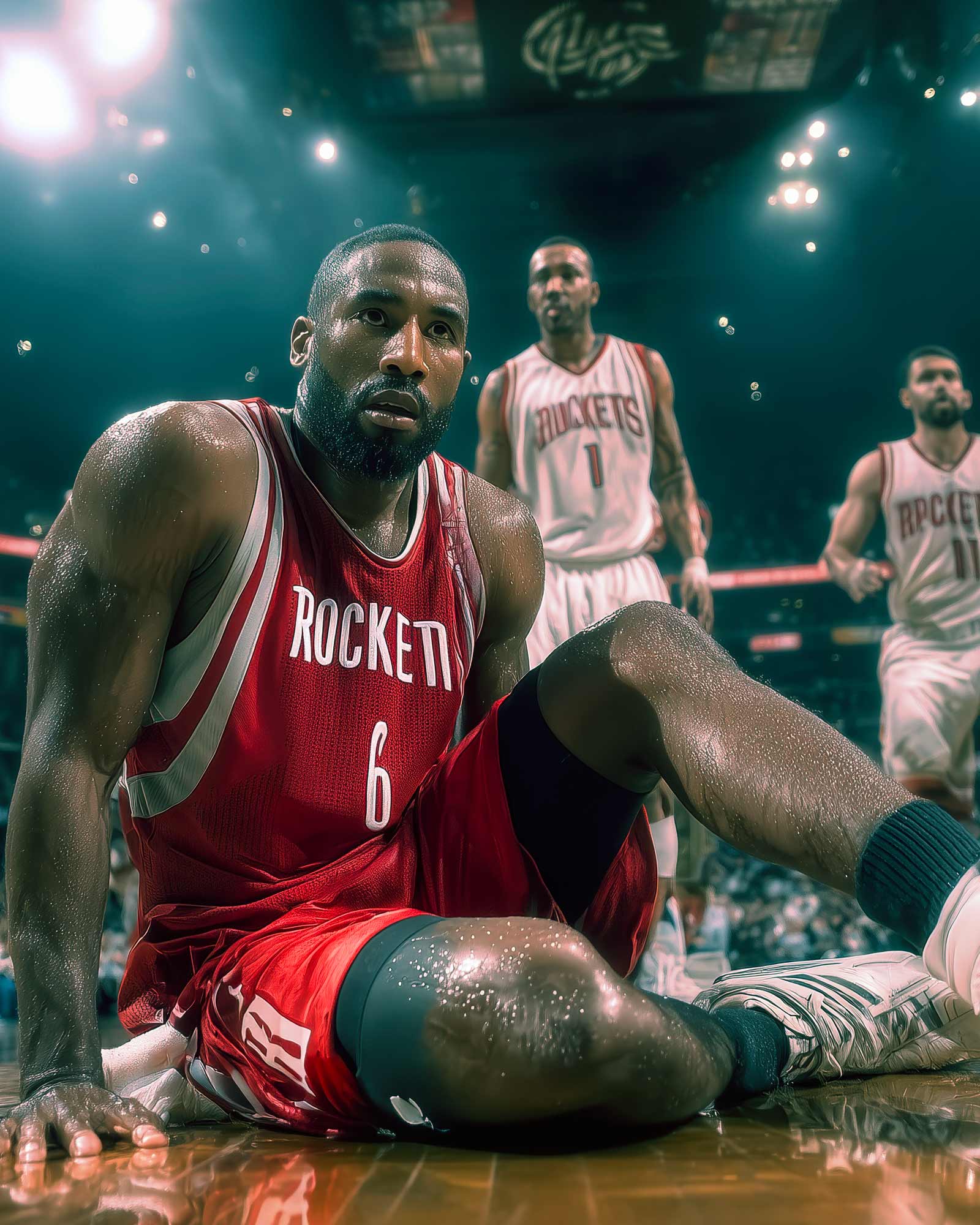The NBA season is only a few weeks old, yet the impact of player absence through injury is already being felt. High-profile players are missing games at an unprecedented rate, and the conversation in the media has turned away from last ditch defensive blocks and breathtaking 3-pointers, and towards a troubling rise in soft-tissue injuries. Calf strains, hamstring pulls, groin problems and tendon issues are keeping stars sidelined for weeks, already potentially changing the shape of the season.
Among the most vocal voices has been Golden State Warriors coach Steve Kerr, who has blamed a combination of the increased pace of play around the league and the relentless nature of the NBA’s 82-game schedule for the current situation.
“I’m very concerned. It’s dramatic, the pace difference is dramatic. I think across the league, everybody understands now that it’s just easier to score if you can beat the opponent down the floor, get out in transition. But when everybody’s doing that, the games are much higher-paced, faster-paced, and then everyone has to cover out to 25 feet. So, we have all the data. Players are running faster and further than ever before, and so we’re trying to do the best we can to protect them, but basically, we have a game every other night and it’s not an easy thing to do.”
Kerr added that his medical staff believes
“the wear and tear, the speed, the pace, the mileage is factoring into these injuries.”
And Kerr isn’t the only one thinking that way, with his view being endorsed by other NBA coaches.
Kerr’s comments seem to capture the essence of the problem. Today the NBA is faster and more physically demanding than ever before, a situation which is amplified by a schedule which inevitably leads to an accumulation of player load. The result is a higher proportion of injuries that are fatigue-related rather than isolated traumatic events, with reporting and early-season surveillance flagging the rise in playing time lost due to soft-tissue injury.
Soft-tissue injuries are especially damaging to teams
Soft-tissue injuries matter because they directly impact availability, performance, and continuity. Players are commonly sidelined for weeks, causing them not only to miss important games but creating disruption to the rhythm of the team in the early weeks of the season. In addition to this soft-tissue injuries have a high chance of reoccurring, and when a star player is repeatedly in and out of the line-up, the tactical, commercial and psychological impacts can ripple throughout the roster. Coaches must change rotations, fringe players have to take on more minutes, and team chemistry suffers. And this season, the players who have been missing are some of the NBA’s biggest names: Giannis Antetokounmpo with a groin strain; Anthony Davis, Victor Wembanyama, Dylan Harper and Ja Morant with calf strains; Stephon Castle with a hip injury. From a league perspective, the visible absence of these marquee names impacts fan engagement and broadcast revenues, which is why this season’s injury situation has suddenly become a headline grabbing topic.
Soft-tissue injuries have multifactorial causes
Systemic injury trends such as the one currently emerging in the NBA rarely have a single cause. Basketball coaches and team officials point towards several interacting drivers, including:
- Faster pace and more possessions: Modern offenses emphasize transition and pace, forcing defenders to sprint more and to cover more ground per game. Kerr and other coaches have noted that the league’s average pace has risen, and that players are producing more high-intensity running than in previous eras.
- Increased spacing and perimeter play: More perimeter shooting spreads defenses thinner, demanding repeated high-velocity runs from players who must contest long-range shots and recover defensively.
- Cumulative minutes: With fewer players available, coaches have less options to spread the playing burden throughout the squad. This results in players having to be on court for longer, and even relatively small game minute increases can accumulate to produce chronic fatigue if not detected and managed early.
- Training and load-management paradoxes: Some practitioners argue that an over-reliance on rest or excessively conservative load management can lead to players being unprepared to meet these increased physical demands. The result is an under-conditioning of soft tissues, leaving them susceptible to injury during sprint actions or when loaded in game scenarios. For this reason, practitioners must consider balancing appropriate recovery with robust, basketball-specific conditioning.
The multifaceted nature of soft-tissue injuries creates a significant problem for NBA teams. Specifically, with so many factors contributing to injury occurrence, how do they pinpoint those players who are at risk quickly and accurately? The answer may be for teams to invest in more sophisticated monitoring systems which provide staff with an early warning of when and how to intervene to prevent soft-tissue breakdown.
How Apollo makes a measurable difference
Basketball teams who want to reduce soft-tissue injuries can no longer rely on the gut feeling of coaching staff alone; they need integrated data, consistent monitoring, insightful reports and seamless communication flows. And in these key areas, Apollo has the capacity to equip teams with an unparalleled ability to mitigate injury risks and enhance overall performance levels.
- Centralized load and readiness data
Apollo collects GPS and heart rate data from practices, player wellness scores, gym outputs including velocity and force plate metrics, and subjective feedback such as RPE and muscle soreness. It then combines these data streams into a single athlete profile, which enables staff to quickly spot players who may be at increased risk. For example, identifying when a player’s acute load is climbing relative to their chronic exposure – a factor which has been shown to be a risk factor for muscle strain – allows coaches to proactively adjust practice conditions or training in the weight room. - Delivering early warning signals with AI
Soft-tissue injuries are often preceded by subtle declines in physical metrics, such as reduced in-game sprint outputs and higher perceived muscle soreness. When viewed manually in isolation, these warning signals can often be missed, however, Apollo has the power to employ machine-learning models which can quickly assimilate multiple data points in conjunction with injury history to flag athletes at risk onto an injury forecasting dashboard. In addition, Apollo’s AI powered chatbot allows staff to instantly access individual performance data in real time, while automated alerts remove the ‘noise’ from data and help medical, coaching and S&C staff concentrate their focus towards where intervention is needed most. - Monitoring fatigue and player readiness
Performance staff in the NBA often use multiple different tools to benchmark recovery and establish performance readiness. Although each of these measurement tools are valuable, when used collectively the sheer volume of information they produce can often become confusing. Apollo streamlines and visualizes these recovery trends into a customized report, helping staff to decide when a player needs extra recovery, modified loading, or even targeted strength work for identified soft-tissue risk areas. In this way, Apollo creates an environment in which each teams fatigue monitoring system becomes greater than the sum of its parts. - Enabling coordinated multidisciplinary decisions
Soft-tissue risk management is a multi-departmental effort: doctors, physiotherapists, S&C coaches, sports scientists and nutritionists must coordinate closely. Apollo provides a single language and shared dashboards so that everyone sees the same data, rehab progressions, and clearance criteria. This reduces miscommunication and increases the likelihood of staff making effective and accurate player decisions. - Tracking interventions and outcomes
Implementing strength programs, tailoring conditioning drills, or adjusting travel recovery protocols is only part the injury reduction process; NBA teams must also evaluate the effect those interventions are having in reducing their injuries. Apollo allows staff to track intervention compliance, compare injury incidence pre/post protocol, and iterate based on outcomes.
Apollo in practice: catching a calf strain before it occurs
We have seen that a number of star players have already missed games this season with calf strains, so let’s create an imaginary scenario which describes how Apollo would address this particular problem….
Game analysts at an NBA team have logged increased sprint distance outputs for a veteran point guard over the previous five games. The medical team collect daily wellness entries, which now report a rising tightness in the players right calf. At the same time, interns from the fitness department record a small but consistent decline in the players single leg hop force on the right side. This data is all sitting on different systems, but with Apollo it doesn’t remain isolated, instead it is all automatically pulled onto a centralized platform and correlated. The system then automatically flags a high-risk alert, prompting the performance team to inform the coaching staff about the potential calf issue. The coaches then subsequently modify training conditions to restrict the players sprint exposure in practice, whilst at the same time S&C staff implement isometric calf loading exercises into the players program, and the therapists perform targeted soft-tissue mobility work. Over the coming days, sport science staff closely monitor the players response to these interventions, ensuring the process is having the required effect, and the injury risk gradually subsides.
In this scenario, instead of data from multiple different departments sitting in silos waiting for an acute calf strain to happen, Apollo has enabled the analysis, medical, performance, coaching and sport science teams to share vital player information, collaborate effectively and perform an early intervention. This is a textbook example of how Apollo allows injury prevention to be driven by integrated monitoring, cross-departmental communication and informed decision making. In this regard Apollo doesn’t replace expert practitioners; it amplifies them. Data without interpretation is just noise, and tools must be embedded into workflows that are trusted by coaches and players alike. Successful sports teams around the globe are using insights generated by Apollo, coupled with the clinical judgment and professional experience of their staff, to make informed decisions which reduce their injury burden.
Protecting players is protecting the game
The spike in soft-tissue injuries so early in this NBA season has shaken stakeholders, from coaches like Steve Kerr raising alarms to the league investing in biomechanics programs. The response to this should not be reactionary, it must be systematic. Teams that adopt integrated monitoring, evidence-based load management, and multidisciplinary communication will be best placed to reduce soft-tissue risk and keep their players on the floor. This is where Apollo can become indispensable. As Kerr noted, the game is faster and the margins are small. But with Apollo in place, teams can tilt the odds back in their favor, protecting player welfare and increasing the likelihood of competitive success.
Apollo can make a real difference to your team
Apollo’s athlete performance software unlocks data silos allowing coaches, trainers, doctors and players to become masters of data-driven performance with real-time data visualization and collaboration tools. With Apollo, teams have the information they need to minimize injuries and optimize player availability.
To learn more about using Apollo for injury reduction, email info@apollov2.com.




